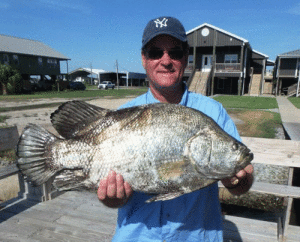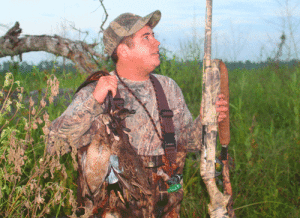
Big tripletails, like this one, are not only tasty, but surprisingly easy to catch around structure and floating debris in West Matagorda Bay, and just outside the Port O’Connor jetties.
A tripletail is one of the wackiest fish you’ll ever see, or catch. They taste great, fight hard and can be caught right about now and into September on West Matagorda Bay and within a mile or so outside the Port O’Connor jetties. The great thing about a tripletail is that it will hit small jigs and live or dead shrimp all day long.
These fish get big. The Texas record weighed 33.50 pounds and was caught on June 29, 1984 by Edie Pruitt while fishing on Matagorda Bay. In fact, this particular bay is the go-to body of water to find record setting tripletails in August and September.
There are a few areas along the Texas coast where tripletails are most abundant. TPWD’s coastal fisheries catch data shows that the near shore structure off the Sabine jetties produces the most tripletail. The Gulf off Galveston and Matagorda are the second and third highest producers. In Texas bays, however, West Matagorda Bay is where most tripletail are usually caught by recreational anglers and in TPWD gill nets. Why Matagorda Bay is so appealing to tripletail is a mystery. It could be due to a combination of the number of pilings and platforms and the salinity.
“The most characteristic and certainly one of the most unusual behaviors exhibited by these fish is to lie just below the surface, floating with one side exposed, looking for all intents, dead,” says Bill Balboa, TPWD’s Matagorda Bay Ecosystem Leader. “To my knowledge, there has been no scientific evaluation of why tripletail behave in this manner. I suppose it is not unreasonable to speculate that this trait may relate to either thermal regulation or as a feeding strategy as they “lie in wait” for an unsuspecting prey item to assume a position under their floating bodies. The latter seems the most feasible since tripletail are often found near weed lines and many of their prey items would naturally be fish that are associated with floating structures.”
Tripletail are most often seen and caught near structure like wells, pilings and floating objects such as wooden pallets and weed lines. They also prefer the mouths of rivers, passes and bays opening into the Gulf. It is this affinity that makes tripletail a relatively easy target for anglers. It’s usually a matter of locating structures or “weed lines” holding tripletail, placing a bait near the waiting fish, and then it’s game on. The biggest obstacle to landing these fish is trying to pull them away from pilings or other obstacles before they wrap or tangle the line and break-off.
One of the best baits you can use to catch these fish is a peeled shrimp on a No. 3 or 4 Mustad Wide Gap croaker hook. I like to skewer a peeled shrimp on the hook. When a tripletail is spotted it’s just a matter of pitching the bait past the fish and reeling it up within eyesight. Definitely don’t hit the fish with the bait or lure. It’ll spook and not come back any time soon.
Another option is to rig a small piece of peeled shrimp on the treble hook behind a ¼ or ½ ounce silver spoon. I’ve caught quite a few big tripletails with this lure/bait combo.
When it comes to good eating fish it’s tough to beat a tripletail. The flesh is firm and white and is considered by many to be equal to or superior to red snapper or grouper.
Hot bite on speckled trout
Catches of trout have been off the charts the past few weeks. Most are being caught on live shrimp and croakers. When fishing the shallow guts along island shorelines the best rig is a 24-inch leader under a Bomber Paradise Popper rattle float. Tie on a No. 4 Eagle Claw red treble hook, add a live shrimp and you’re ready to go. Don’t forget to pinch on a 1/8 ounce split shot.
Croakers have been best when rigged about 18 inches under an inline rattler. They are producing the most trout when either free-lined or fished on bottom with a ¼ ounce barrel weight.
Book your September teal hunts now.
Something duck hunters can look forward to is another banner teal season in September. Both blue and green winged teal numbers are through the ceiling. Green-winged teal numbers are at 4.1 million, which is 19 percent above the 2014 estimate and 98 percent above the long-term average. The blue-winged teal population is right at 8.5 million, which is similar to the 2014 estimate and 73 percent above the long-term average.
“Duck hunters can anticipate improved conditions for the September early teal season as abundant rains have filled lakes and marshes for the first time in several years,” says TPWD’s Steve Lightfoot. “With record numbers of teal expected to make their way into Texas prospects should be good.”
The 16-day teal season will run Saturday, Sept. 12 through Sunday, Sept. 27. The daily bag on teal will be six.
Guide Dwayne Lowrey says he is now booking hunts for the September teal season. He runs a first class operation. He’ll be hunting over freshwater ponds within a 15 minute drive from Port O’Connor. You can hunt in the morning and fish in the afternoon. Give him a call at 713-410-1338.
For guided boat or wade fishing trips out of Port O’Connor call Capt. Robert Sloan at 409-782-6796, email at sloan288@aol.com or check out www.luckystrikeguide.com.

Teal hunters can look forward to another banner teal season in September. The 16-day season will run Saturday, September 12 through Sunday, September 27. The daily bag on teal will be six. For guided hunts out of Port O’Connor call Dwayne Lowrey at 713-410-1338. -Captain Robert Sloan
